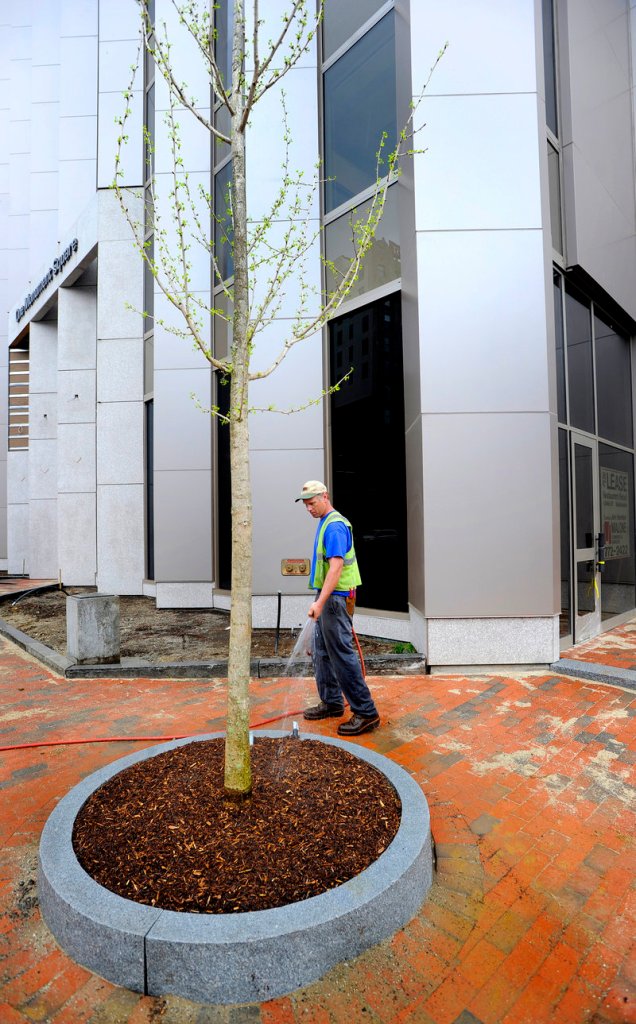PORTLAND – “I read that there are plans to plant trees in Monument Square,” read the e-mail from Mathew Holmes to the city arborist. “This sounds like a great idea. I heard that you are considering planting ginkgo trees. PLEASE, tell me they aren’t the kind of ginkgo trees found on Brackett and Clark streets. As I’m sure you know, those trees are considered a menace by all that live or walk by them due to their berries that smell like vomit and get on your shoes and on vehicles parked under them. My daughter refers to them as ‘stinko ginkgoes’ and I have heard other neighbors refer to them as ‘puke trees.’ Please do not permit them in Monument Square.”
There is more to planting a tree than digging a hole and remembering to water it.
Ask Jeff Tarling, Portland’s arborist.
When news got out about a tree planting project in Monument Square this spring, his e-mail inbox was flooded with opinions about what varieties should go into the 15 planter wells.
People in Portland, he said, take their trees seriously. His department has received more than 1,600 phone calls in the past year from people who wanted a say in foliage decisions here, a place known as the “Forest City” almost from its inception.
With the season shifting into high gear, Tarling and the city’s forestry division are planting the 200 to 300 new trees that go into the ground along city streets and in parks each year. Most of them will be bought with donations by businesses and residents to the city’s tree trust.
Residents buy the trees from four co-op nurseries for planting on city rights of way. The city provides advice about appropriate species, delivers the trees, then plants and maintains them.
Portland is one of only 17 communities in Maine that qualify as a Tree City USA, a designation established by the Arbor Day Foundation and the National Association of State Foresters to encourage urban tree cultivation.
To qualify, a community must have a tree board or department and a tree care ordinance, spend at least $2 per capita on trees annually and celebrate Arbor Day, said Jan Santerre, a senior planner with the Maine Forest Service.
Santerre coordinates Project Canopy, a federally funded statewide program that helps communities manage their urban trees and awards them Tree City USA status.
While the rest of the country observes Arbor Day in April, Mainers pay homage to their trees during the third full week in May — this year starting May 16. A group of schoolchildren petitioned the Legislature in the 1970s to make the change because the ground here is often still frozen in April.
Arbor Day is a big deal in the treeless Plains States such as Nebraska. “But not so much in the Northeast, because we are so heavily forested,” Santerre said.
That’s not the case in Portland and Maine’s other Tree City USA designees.
Portland’s tree-planting history dates back to at least 1793, when trees were planted on Washington Avenue.
Tarling said tree species have come in and out of fashion.
Norway maples were favored around 1900, but are eschewed today as invasive. Elms were immensely popular, until Dutch elm disease hit the state in the 1960s, wiping out 20,000 of the trees on Portland’s peninsula alone.
Littleleaf Lindens were in during the 1970s, although their tendency to develop sooty mold that coats cars and siding with a black film has cooled some of the enthusiasm, Tarling said.
An arborist can leave a mark on a city’s landscape. Tarling said Keith Jones, Portland’s arborist in the 1970s and 1980s, ushered in an era of species diversification.
“The city went from planting monocultures to trying lots of trees,” Tarling said.
His favorite tree is a sugar maple at Fort Allen Park on the Eastern Prom. So when the Rotary Club of Portland donated enough money for any tree Tarling wanted, he chose a companion for his favorite sugar maple, which will be the backup if anything goes wrong with his favorite.
He also is partial to a ginkgo, planted sometime in the 1800s, at the corner of Ashmont and Deering streets.
Nurseries are supposed to sell only male ginkgoes, but occasionally some female trees get through, with their smelly fruit. It becomes obvious only when the trees reach maturity about 20 years later.
While some property owners see trees as a potential menace, others find them comforting.
Carla Bella Maddrell, who owns the Carla Bella clothing shop on Fore Street, is the unofficial tree warden in her neighborhood. She monitors the health of the trees and calls Tarling if any appear to be ailing.
She said she has to protect them from abuse because people use them as bike racks and do other damage.
“Trees soften the neighborhood, make it less urban,” she said.
When Belinda Ray spotted spray paint on the sidewalks along East Oxford Street this spring, she got excited because it meant that trees would be coming to her East Bayside neighborhood. She said the area is virtually treeless, and feels hot and barren in the summer.
“If you walk down streets on Munjoy Hill, there are beautiful canopies and it feels so homey, welcoming and inhabited,” said Ray, a community organizer.
When the city plants trees, she said, it’s a goodwill gesture that makes the neighborhood feel like it is getting some attention.
Picking the right tree for the right location is essential, said Tarling.
He struggled to decide what to plant in Monument Square. At one point he was leaning toward ginkgoes. But e-mailer Holmes and his daughter, Hazel, 5, may be happy to learn that Tarling went with hackberries.
Staff Writer Beth Quimby can be contacted at 791-6363 or at:
bquimby@pressherald.com
Send questions/comments to the editors.



